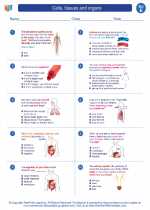Cells, tissues and organs -> comparative anatomy
Comparative Anatomy
Comparative anatomy is the study of similarities and differences in the anatomy of different species. It involves the comparison of the structures of organisms in order to understand their evolutionary relationships. By studying comparative anatomy, scientists can gain insights into the evolutionary history of organisms and understand how different species are related to each other.
Importance of Comparative Anatomy
Comparative anatomy is important because it provides evidence for the theory of evolution. By comparing the anatomical features of different species, scientists can identify similarities and differences that indicate shared ancestry and evolutionary relationships. This helps in understanding the evolutionary history and biological diversity of life on Earth.
Key Concepts in Comparative Anatomy
- Homologous Structures: These are anatomical structures that are similar in different species because they are inherited from a common ancestor. For example, the forelimbs of humans, bats, and whales have the same basic bone structure, indicating a common evolutionary origin.
- Analogous Structures: These are structures that have similar functions in different species but are not derived from a common ancestor. For example, the wings of birds and insects have similar functions (flight) but have evolved independently.
- Vestigial Structures: These are anatomical structures that have lost their original function in the course of evolution. For example, the human appendix is thought to be a vestigial structure that was once used for digestion in our evolutionary ancestors.
Study Guide for Comparative Anatomy
1. Understanding Homologous and Analogous Structures
- Definition of Homologous Structures: Homologous structures are anatomical features that are similar in structure and position but may have different functions. Provide examples and illustrations to help understand the concept.
- Definition of Analogous Structures: Analogous structures are anatomical features that have similar functions but may have different structures and evolutionary origins. Provide examples and comparisons to demonstrate the concept.
2. Identifying Vestigial Structures
- Definition of Vestigial Structures: Vestigial structures are anatomical features that have lost their original function through evolution. Provide examples of vestigial structures in different species and discuss their significance in understanding evolutionary history.
3. Comparative Anatomy and Evolution
- Explain the role of comparative anatomy in providing evidence for evolution: Discuss how the comparison of anatomical structures across different species supports the theory of evolution. Provide specific examples and case studies to illustrate this relationship.
4. Evolutionary Relationships and Phylogenetic Trees
- Understanding phylogenetic trees: Explain how phylogenetic trees are constructed based on comparative anatomy to depict the evolutionary relationships between different species. Provide examples and diagrams to illustrate the construction and interpretation of phylogenetic trees.
5. Practical Comparative Anatomy
- Comparative anatomy dissection: If possible, engage in a comparative anatomy dissection activity to compare the anatomical structures of different organisms. This hands-on experience can provide a deeper understanding of the similarities and differences in anatomy across species.
By mastering the concepts of comparative anatomy and understanding its significance in evolutionary biology, students can gain a comprehensive understanding of the diversity of life and the interconnectedness of different species through evolutionary history.
Use this study guide to explore the fascinating world of comparative anatomy and its role in shaping our understanding of the natural world.
[Comparative Anatomy] Related Worksheets and Study Guides:
.◂Science Worksheets and Study Guides Fifth Grade. Cells, tissues and organs

 Worksheet/Answer key
Worksheet/Answer key
 Worksheet/Answer key
Worksheet/Answer key
 Worksheet/Answer key
Worksheet/Answer key
 Vocabulary/Answer key
Vocabulary/Answer key
 Vocabulary/Answer key
Vocabulary/Answer key
 Vocabulary/Answer key
Vocabulary/Answer key
 Vocabulary/Answer key
Vocabulary/Answer key
 Vocabulary/Answer key
Vocabulary/Answer key
 Vocabulary/Answer key
Vocabulary/Answer key
